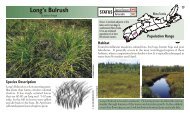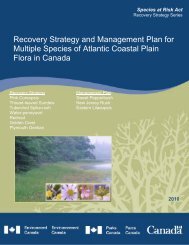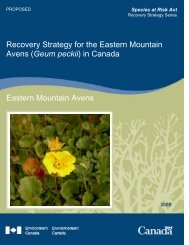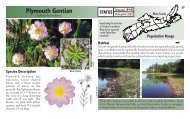Healthy Lakes and Wetlands For Tomorrow - Species at Risk
Healthy Lakes and Wetlands For Tomorrow - Species at Risk
Healthy Lakes and Wetlands For Tomorrow - Species at Risk
Create successful ePaper yourself
Turn your PDF publications into a flip-book with our unique Google optimized e-Paper software.
FORESTRY PRACTICES<br />
<strong>For</strong>estry practices impact the l<strong>and</strong>scape, <strong>and</strong> good planning with sound ecological<br />
management can go a long way towards preventing damage to wildlife habit<strong>at</strong>. Both large<br />
forestry companies <strong>and</strong> small woodlot owners are a vital component for the stewardship<br />
of species <strong>at</strong> risk in forested l<strong>and</strong>scapes. In Nova Scotia, forestry activities occur largely on<br />
priv<strong>at</strong>ely owned l<strong>and</strong>. Small woodlot owners own almost half of the forested l<strong>and</strong> in this<br />
province <strong>and</strong> can make a huge difference by using sustainable forestry techniques. The<br />
following are recommended forestry practices for l<strong>and</strong>s with species <strong>at</strong> risk.<br />
Avoid harvesting in Bl<strong>and</strong>ing’s Turtle<br />
nesting habit<strong>at</strong> in June.<br />
This will minimize danger to female turtles<br />
travelling to nesting sites.<br />
Bl<strong>and</strong>ing’s Turtle<br />
Boreal Felt Lichen<br />
American Marten<br />
Practice uneven-aged management using techniques such as (but not limited to)<br />
selection harvesting <strong>and</strong> p<strong>at</strong>ch cutting.<br />
Currently, even-aged management through clearcutting is the most common harvest practice (over 90%)<br />
in Nova Scotia. This cre<strong>at</strong>es a forest with trees th<strong>at</strong> are of one age class <strong>and</strong> similar height. Some species,<br />
such as balsam fir <strong>and</strong> white birch, may be found in even-aged st<strong>and</strong>s because of their n<strong>at</strong>ural disturbance<br />
p<strong>at</strong>terns. Uneven-aged management helps to maintain the forests n<strong>at</strong>ural biodiversity <strong>and</strong> structural<br />
components by maintaining forest cover, improving st<strong>and</strong> quality, <strong>and</strong> having a woodlot composed of<br />
diverse ages <strong>and</strong> species. Uneven-aged management offers long-term rewards such as an increase in the<br />
harvest volume of select valuable trees, which can benefit the l<strong>and</strong>owner <strong>and</strong> the cre<strong>at</strong>ures th<strong>at</strong> share<br />
their l<strong>and</strong>. High value trees th<strong>at</strong> thrive in uneven-aged Acadian forests include red spruce, sugar maple,<br />
yellow birch, beech, <strong>and</strong> hemlock.<br />
Maintain the n<strong>at</strong>ural veget<strong>at</strong>ion <strong>and</strong> forest canopy around w<strong>at</strong>ercourses.<br />
Practicing uneven-aged management will help to maintain the forest canopy throughout the woodlot<br />
<strong>and</strong> will be beneficial to wildlife <strong>and</strong> the w<strong>at</strong>ercourse. If you are practicing even-aged management <strong>and</strong><br />
harvesting all the trees in an area, the Nova Scotia <strong>For</strong>ests Act requires a 20 m Special Management Zone<br />
along w<strong>at</strong>ercourses. A veget<strong>at</strong>ed zone th<strong>at</strong> is <strong>at</strong> least one to two tree lengths would be better, with 100 m<br />
(330 feet) ideal.<br />
Incorpor<strong>at</strong>e tree marking into your woodlot management.<br />
Tree marking is the practice of carefully considering which trees to harvest based on tree size, health,<br />
39








